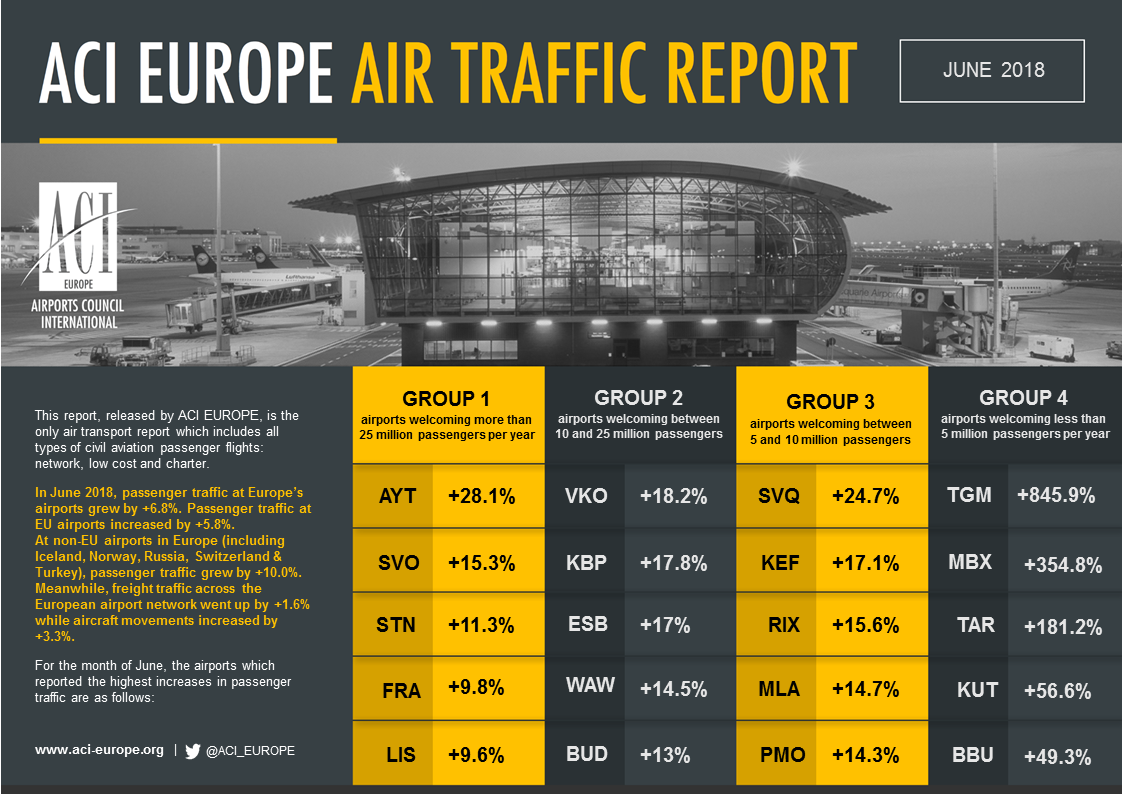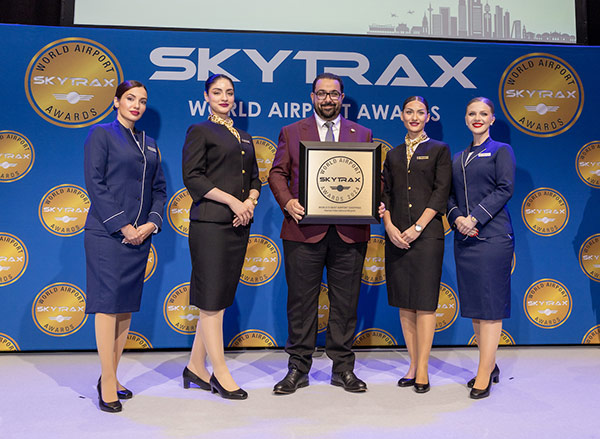
EUROPE. Passenger traffic at Europe’s airports was up +6.7% year-on-year in the first half of 2018, trade organisation ACI Europe has reported.
Passenger growth in June was marginally higher than this average, at +6.8%. The second quarter saw slower growth than the first quarter, at +6%.
In the first half, passenger traffic in the less mature non-EU market increased +10.5%. That figure is nearly twice the expansion rate of the EU market’s +5.4%. Both markets saw the growth dynamic recede slightly in the second quarter compared to the first – from +12.5% to +9.4% at non-EU airports and from +6.2% to +4.9% at EU airports.
In the EU, airports in the Baltic States, Bulgaria, Croatia, the Czech Republic, Greece, Hungary, Luxembourg, Malta, Poland, Slovakia and Slovenia achieved double-digit growth in the first half.
Airports in Sweden posted the lowest growth within Europe, at +1.5%. ACI Europe attributed this to a combination of a new national aviation tax introduced last April, the bankruptcy of regional airline Nextjet and lower outbound demand in the wake of local currency hitting its lowest value in years. Sweden was the only European market to see passenger traffic fall in June (-0.4%), with its new aviation tax among the factors leading to the improved performance of airports in neighbouring Denmark (+5.7%).
In the non-EU market, passenger traffic grew in excess of +15% at airports in Turkey, Ukraine, Georgia and Israel and Iceland in the first half.

Source (all charts): ACI Europe.
Click on image to enlarge.
Europe’s five busiest airports recorded a passenger traffic increase of +6.3% in the first half. ACI Europe said this was a notable improvement over the increase in 2017 (+4.3%). Istanbul-Atatürk topped the league in terms of growth, at +12.9%, followed by Frankfurt (+9.1%). Amsterdam-Schiphol also reported robust growth of +5.4%. Paris Charles de Gaulle saw passenger traffic increase +3%, but its performance was impacted by repeated strikes at Air France. Traffic at capacity constrained London Heathrow was up +2.6%.
Many secondary and smaller hubs saw stronger growth, ACI Europe noted, as did selected medium sized and larger regional airports. This reflects “ever evolving competitive dynamics largely driven by low cost carriers and non-EU full service carriers, the organisation said.

Click on image to enlarge.
These airports include: Istanbul Sabiha Gökçen (+12.4%), Lisbon (+12.9%), Milan Malpensa (+11.1%), Athens (+11.4%), Tel Aviv (+13.1%), Helsinki (+12%), Moscow Vnukovo (+19.8%), Warsaw (+14.8%), Prague (+10.3%), Budapest (+14.8%), Naples (+24.7%), Keflavik (+15.6%), Valencia (+20.2%), Krakow (+17.8%), Malta (+16.3%), Sevilla (+26.9%), Palermo (+16.9%), Nantes (+14%) and Heraklion (+14.2%).
“Our expectations for the first half of the year were cautiously positive, not least because of the extraordinary rise in passenger traffic Europe has enjoyed last year,” said ACI Europe Director General Olivier Jankovec. “But the results reveal just how robust air traffic growth has remained so far.
“Such growth is clearly putting our aviation system under pressure – with the impact of both a lack of airport capacity and air traffic management inefficiencies becoming more and more acute and now directly affecting air travellers.”
Jankovec also noted that diminishing growth in freight traffic pointed to the economic risks from trade disputes and their escalation. “Higher prices, disrupted supply chains and wavering exports are likely implications – which would inevitably end up affecting demand for air transport. The increasing odds of a ‘no-deal’ Brexit scenario are just adding to the stress – and could soon start weakening consumer confidence.”

Click on image to enlarge.
During June, airports welcoming more than 25 million passengers per year (Group 1); 10-25 million (Group 2); 5-10 million (Group 3); and under 5 million (Group 4) reported average adjustments of +6.8%, +6.2%, +5.9% and +8.8% respectively.
The airports that reported the highest increases were:
Group 1: Antalya (+28.1%), Moscow Sheremetyevo (+15.3%), London Stansted (+11.3%), Frankfurt (+9.8%) and Lisbon (+9.6%).
Group 2: Moscow Vnukovo (+18.2%), Kiev (+17.8%), Ankara (+17.0%), Warsaw Chopin (+14.5%) and Budapest (+13.0%).
Group 3: Sevilla (+24.7%), Keflavik (+17.1%), Riga (+15.6%), Malta (+14.7%) and Palermo (+14.3%).
Group 4: Targu Mures (+845.9%), Maribor (+354.8%), Taranto (+181.2%), Kutaisi (+56.6%) and Bucharest (+49.3%).












